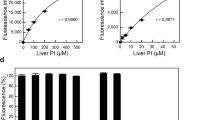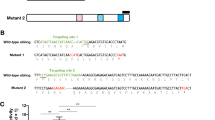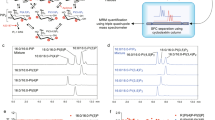Abstract
Phosphoinositides represent a minor fraction of the total glycerolipids in cells. Despite the fact that phosphoinositides are present in small quantities, they have crucial roles during cell signaling and in regulating numerous intracellular processes. Measuring changes in the levels of different phosphoinositides in animals is difficult, but it is essential in order to define the important functions of specific members of the phosphoinositide family. Here we detail procedures for measuring phosphoinositides in 2-days-postfertilization (2-d.p.f.) embryos in zebrafish (Danio rerio). Both in vivo radiolabeling (using [32P]orthophosphate) followed by thin-layer or high-performance liquid chromatography (TLC or HPLC) analysis and specific in vitro phosphorylation assays (using [32P]γATP) permit the quantitative measurement of phosphoinositides. Normalization of both measurements can be achieved by the determination of total lipid phosphate in embryos. All the techniques described are relatively inexpensive and accessible to most laboratories with an interest in studying the effect of gene manipulation on phosphoinositide metabolism in zebrafish. All the procedures described herein will take up to 10 working days.
This is a preview of subscription content, access via your institution
Access options
Subscribe to this journal
Receive 12 print issues and online access
$259.00 per year
only $21.58 per issue
Buy this article
- Purchase on Springer Link
- Instant access to full article PDF
Prices may be subject to local taxes which are calculated during checkout







Similar content being viewed by others
References
Di, P.G. & De, C.P. Phosphoinositides in cell regulation and membrane dynamics. Nature 443, 651–657 (2006).
Balla, T., Szentpetery, Z. & Kim, Y.J. Phosphoinositide signaling: new tools and insights. Physiology (Bethesda) 24, 231–244 (2009).
Fiume, R. et al. Nuclear phosphoinositides: location, regulation and function. Subcell. Biochem. 59, 335–361 (2012).
McCrea, H.J. & DeCamilli, P. Mutations in phosphoinositide metabolizing enzymes and human disease. Physiology (Bethesda) 24, 8–16 (2009).
Vicinanza, M., D'Angelo, G., Di, C.A. & De Matteis, M.A. Phosphoinositides as regulators of membrane trafficking in health and disease. Cell Mol. Life Sci. 65, 2833–2841 (2008).
Wenk, M.R. et al. Phosphoinositide profiling in complex lipid mixtures using electrospray ionization mass spectrometry. Nat. Biotechnol. 21, 813–817 (2003).
Pettitt, T.R. Phosphoinositide analysis by liquid chromatography-mass spectrometry. Methods Mol. Biol. 645, 203–217 (2010).
Clark, J. et al. Quantification of PtdInsP3 molecular species in cells and tissues by mass spectrometry. Nat. Methods 8, 267–272 (2011).
Morris, J.B., Hinchliffe, K.A., Ciruela, A., Letcher, A.J. & Irvine, R.F. Thrombin stimulation of platelets causes an increase in phosphatidylinositol 5-phosphate revealed by mass assay. FEBS Lett. 475, 57–60 (2000).
Clarke, J.H. et al. Inositol lipids are regulated during cell cycle progression in the nuclei of murine erythroleukaemia cells. Biochem. J. 357, 905–910 (2001).
Guillou, H. et al. Use of the GRP1 PH domain as a tool to measure the relative levels of PtdIns(3,4,5)P3 through a protein-lipid overlay approach. J. Lipid Res. 48, 726–732 (2007).
Chicanne, G. et al. A novel mass assay to quantify the bioactive lipid PtdIns3P in various biological samples. Biochem. J. 447, 17–23 (2012).
Lieschke, G.J. & Currie, P.D. Animal models of human disease: zebrafish swim into view. Nat. Rev. Genet. 8, 353–367 (2007).
Santoriello, C. & Zon, L.I. Hooked! Modeling human disease in zebrafish. J. Clin. Invest. 122, 2337–2343 (2012).
Montero, J.A., Kilian, B., Chan, J., Bayliss, P.E. & Heisenberg, C.P. Phosphoinositide 3-kinase is required for process outgrowth and cell polarization of gastrulating mesendodermal cells. Curr. Biol. 13, 1279–1289 (2003).
Van Epps, H.A. et al. The zebrafish nrc mutant reveals a role for the polyphosphoinositide phosphatase synaptojanin 1 in cone photoreceptor ribbon anchoring. J. Neurosci. 24, 8641–8650 (2004).
Faucherre, A., Taylor, G.S., Overvoorde, J., Dixon, J.E. & Hertog, J. Zebrafish pten genes have overlapping and non-redundant functions in tumorigenesis and embryonic development. Oncogene 27, 1079–1086 (2008).
Ma, H., Blake, T., Chitnis, A., Liu, P. & Balla, T. Crucial role of phosphatidylinositol 4-kinase IIIα in development of zebrafish pectoral fin is linked to phosphoinositide 3-kinase and FGF signaling. J. Cell. Sci. 122, 4303–4310 (2009).
Jurynec, M.J. & Grunwald, D.J. SHIP2, a factor associated with diet-induced obesity and insulin sensitivity, attenuates FGF signaling in vivo. Dis. Model. Mech. 3, 733–742 (2010).
Rbaibi, Y. et al. OCRL1 modulates cilia length in renal epithelial cells. Traffic 13, 1295–1305 (2012).
Luo, N. et al. OCRL localizes to the primary cilium: a new role for cilia in Lowe syndrome. Hum. Mol. Genet. 21, 3333–3344 (2012).
Coon, B.G. et al. The Lowe syndrome protein OCRL1 is involved in primary cilia assembly. Hum. Mol. Genet. 21, 1835–1847 (2012).
Luo, N., Lu, J. & Sun, Y. Evidence of a role of inositol polyphosphate 5-phosphatase INPP5E in cilia formation in zebrafish. Vision Res. 75, 98–107 (2012).
Pan, W. et al. CDP-diacylglycerol synthetase-controlled phosphoinositide availability limits VEGFA signaling and vascular morphogenesis. Blood 120, 489–498 (2012).
Lambaerts, K. et al. Syntenin, a syndecan adaptor and an Arf6 phosphatidylinositol 4,5-bisphosphate effector, is essential for epiboly and gastrulation cell movements in zebrafish. J. Cell Sci. 125, 1129–1140 (2012).
Ramirez, I.B. et al. Impaired neural development in a zebrafish model for Lowe syndrome. Hum. Mol. Genet. 21, 1744–1759 (2012).
Sarkes, D. & Rameh, L.E. A novel HPLC-based approach makes possible the spatial characterization of cellular PtdIns5P and other phosphoinositides. Biochem. J. 428, 375–384 (2010).
Ndamukong, I., Jones, D.R., Lapko, H., Divecha, N. & Avramova, Z. Phosphatidylinositol 5-phosphate links dehydration stress to the activity of Arabidopsis trithorax-like factor ATX1. PLoS ONE 5, e13396 (2010).
Schacht, J. Purification of polyphosphoinositides by chromatography on immobilized neomycin. J. Lipid Res. 19, 1063–1067 (1978).
Palmer, F.B. Chromatography of acidic phospholipids on immobilized neomycin. J. Lipid Res. 22, 1296–1300 (1981).
Fuchs, B., Suss, R., Teuber, K., Eibisch, M. & Schiller, J. Lipid analysis by thin-layer chromatography–a review of the current state. J. Chromatogr. A 1218, 2754–2774 (2011).
Dove, S.K. et al. Osmotic stress activates phosphatidylinositol-3,5-bisphosphate synthesis. Nature 390, 187–192 (1997).
Jones, D.R. et al. The identification of phosphatidylinositol 3,5-bisphosphate in T-lymphocytes and its regulation by interleukin-2. J. Biol. Chem. 274, 18407–18413 (1999).
Halstead, J.R. et al. A role for PtdIns(4,5)P(2) and PIP5Kalpha in regulating stress-induced apoptosis. Curr. Biol. 16, 1850–1856 (2006).
Divecha, N. Methods to assess changes in the pattern of nuclear phosphoinositides. Methods Mol. Biol. 645, 165–177 (2010).
Acknowledgements
Financial support for the Cancer Research UK Inositide Laboratory is entirely from Cancer Research UK. This work was supported by a Wellcome Trust project grant (079615) and a research grant from the UK Lowe Syndrome Trust awarded to M.L. (ML/MU/DEC07).
Author information
Authors and Affiliations
Contributions
D.R.J. and I.B.-R.R. designed and performed the experiments and analyzed the data. D.R.J., I.B.-R.R., M.L. and N.D. wrote the manuscript.
Corresponding authors
Ethics declarations
Competing interests
The authors declare no competing financial interests.
Rights and permissions
About this article
Cite this article
Jones, D., Ramirez, IR., Lowe, M. et al. Measurement of phosphoinositides in the zebrafish Danio rerio. Nat Protoc 8, 1058–1072 (2013). https://doi.org/10.1038/nprot.2013.040
Published:
Issue Date:
DOI: https://doi.org/10.1038/nprot.2013.040
This article is cited by
-
Voltage-sensing phosphatase (Vsp) regulates endocytosis-dependent nutrient absorption in chordate enterocytes
Communications Biology (2022)
-
Importance of Radioactive Labelling to Elucidate Inositol Polyphosphate Signalling
Topics in Current Chemistry (2017)
-
A targeted knockdown screen of genes coding for phosphoinositide modulators identifies PIP4K2A as required for acute myeloid leukemia cell proliferation and survival
Oncogene (2015)
Comments
By submitting a comment you agree to abide by our Terms and Community Guidelines. If you find something abusive or that does not comply with our terms or guidelines please flag it as inappropriate.



